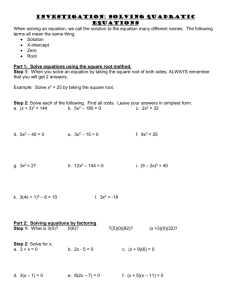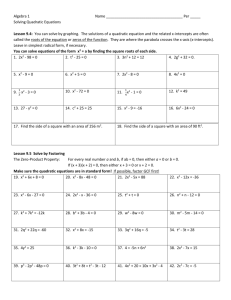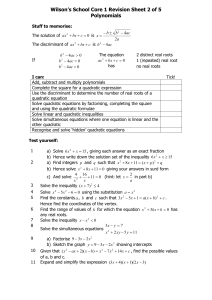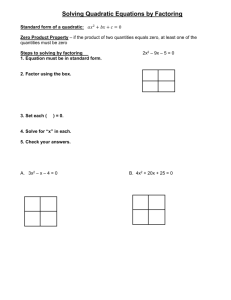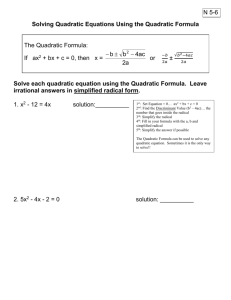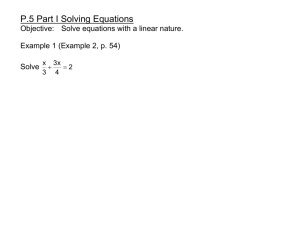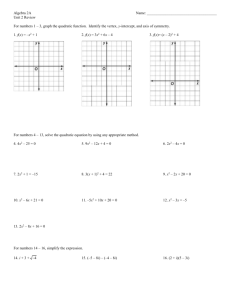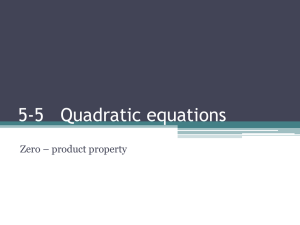Solving Quadratic Equations: 3 Methods
advertisement
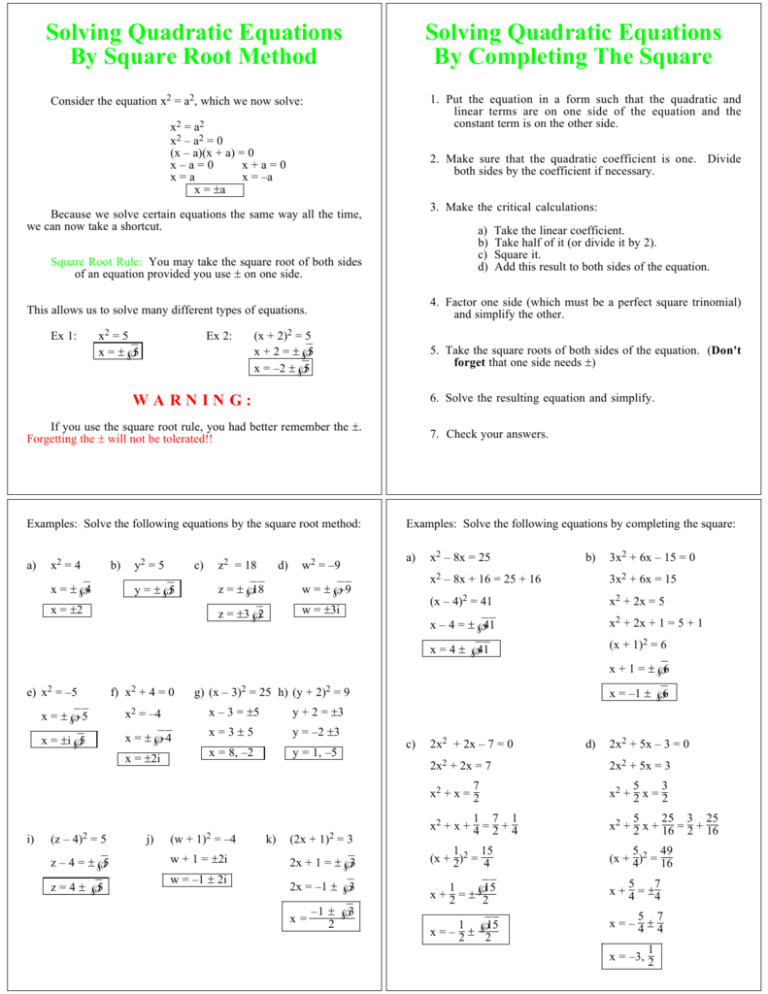
Solving Quadratic Equations By Square Root Method Solving Quadratic Equations By Completing The Square Consider the equation x2 = a2, which we now solve: 1. Put the equation in a form such that the quadratic and linear terms are on one side of the equation and the constant term is on the other side. x 2 = a2 x 2 – a2 = 0 (x – a)(x + a) = 0 x–a=0 x+a=0 x=a x = –a x = ±a 2. Make sure that the quadratic coefficient is one. Divide both sides by the coefficient if necessary. 3. Make the critical calculations: Because we solve certain equations the same way all the time, we can now take a shortcut. a) b) c) d) Square Root Rule: You may take the square root of both sides of an equation provided you use ± on one side. 4. Factor one side (which must be a perfect square trinomial) and simplify the other. This allows us to solve many different types of equations. Ex 1: x2 = 5 x = ± √5 (x + 2)2 = 5 x + 2 = ± √5 x = –2 ± √5 Ex 2: 5. Take the square roots of both sides of the equation. (Don't forget that one side needs ±) 6. Solve the resulting equation and simplify. WARNING: If you use the square root rule, you had better remember the ±. Forgetting the ± will not be tolerated!! Examples: Solve the following equations by the square root method: a) x2 = 4 b) x = ± √4 y2 = 5 c) y = ± √5 x = ±2 Take the linear coefficient. Take half of it (or divide it by 2). Square it. Add this result to both sides of the equation. z2 = 18 d) w2 = –9 z = ± √18 w = ± √–9 z = ±3 √2 w = ±3i 7. Check your answers. Examples: Solve the following equations by completing the square: a) x2 – 8x = 25 b) 3x2 + 6x – 15 = 0 x2 – 8x + 16 = 25 + 16 3x2 + 6x = 15 (x – 4)2 = 41 x2 + 2x = 5 x – 4 = ± √41 x2 + 2x + 1 = 5 + 1 x=4± √41 (x + 1)2 = 6 x + 1 = ± √6 e) i) x2 = –5 f) x2 +4=0 g) (x – 3)2 = 25 h) (y + 2)2 x = ± √–5 x2 = –4 x – 3 = ±5 x = ±i √5 x = ± √–4 x=3±5 y = –2 ±3 x = ±2i x = 8, –2 y = 1, –5 (z – 4)2 = 5 z – 4 = ± √5 z=4± √5 j) (w + 1)2 = –4 w + 1 = ±2i w = –1 ± 2i k) x = –1 ± √6 =9 y + 2 = ±3 c) 2x2 + 2x – 7 = 0 d) 2x2 + 5x – 3 = 0 2x2 + 2x = 7 2x2 + 5x = 3 7 x2 + x = 2 5 3 x2 + 2 x = 2 1 7 1 x2 + x + 4 = 2 + 4 5 25 3 25 x2 + 2 x + 16 = 2 + 16 2x + 1 = ± √3 1 15 (x + 2)2 = 4 5 49 (x + 4)2 = 16 2x = –1 ± √3 1 √15 x+2=± 2 5 7 x + 4 = ±4 1 √ 15 x=–2± 2 5 7 x=–4±4 (2x + 1)2 = 3 x= –1 ± √ 3 2 1 x = –3, 2 e) x2 – 24x + 72 = 0 f) x2 – 3x + 1 = 0 x2 – 24x = –72 x2 – 3x = –1 x2 – 24x + 144 = –72 + 144 9 9 x2 – 3x + 4 = –1 + 4 (x – 12)2 = 72 Examples: Solve the following using the quadratic formula: a) 3 √ 5 x–2=±2 x = 12 ± 6 √2 x = 3 5 x=2±√ 2 g) 3x2 – 6x + 15 = 0 h) x2 + 2x + 2 = 0 x2 + 2x = –2 x2 – 2x = –13 x22 – 2x = –5 x2 + 2x + 1 = –2+1 x2 – 2x +1 = –13+1 x2 – 2x + 1 = –5+1 (x + 1)2 = –1 (x – 1)2 = –12 (x – 1)2 = –4 x + 1 = ±i x – 1 = ±2i x = –1 ± i x – 1 = ±i √12 x = 1 ± 2i Briefly stated, the quadratic formula tell us that if ax2 + bx + c = 0 b 2 – 4ac –b ± √ . You should memorize this with a ≠ 0, then x = 2a formula. These are the steps you should use to solve an equation: 1. Put the equation in standard form. This means you must get a zero on one side of the equation. 2. Identify the corresponding values of a, b, and c. b 2 – 4ac –b ± √ with these values 3. Evaluate the expression 2a of a, b, and c. 4. Simplify the expression. b 2 – 4ac –b ± √ 2a x = b 2 – 4ac –b ± √ 2a –(–5) ± √ (–5) 2 – 4(1)(3) 2(1) = –(–1) ± √ (–1) 2 – 4(5)(–4) 2(5) = 5±√ 25 – 12 2 = 1±√ 1 + 80 10 = 5±√ 13 2 = 1±√ 81 10 x = 5±√ 13 2 = 1 ± 9 10 4 x = 1, – 5 c) x2 + 2x – 4 = 0 a = 1, b = 2, c = –4 x = = = = = 5. Check your answers. = The quantity b 2 – 4ac is called the discriminant and gives us the following information about the solution of the equation. b2 – 4ac > 0 b2 – 4ac = 0 b2 – 4ac < 0 a = 5, b = –1, c = –4 x = 1 ± 2i √3 Solving Quadratic Equations By The Quadratic Formula If If If 5x2 – x – 4 = 0 = i) x2 – 2x + 13 = 0 3x2 – 6x = –15 b) a = 1, b = –5, c = 3 3 5 (x – 2)2 = 4 x – 12 = ± √72 x2 – 5x + 3 = 0 then there are two real solutions. then there is one real solution. then there are no real solutions. (there are two complex solutions) b 2 – 4ac –b ± √ 2a –(2) ± (2) 2 – 4(1)(–4) √ 2(1) –2 ± √ 4 + 16 2 –2 ± √ 20 2 –2 ± 2 √ 5 2 2(–1 ± √ 5) 2 d) 3 2 1 1 4x –2x=3 3 1 1 12( 4 x2 – 2 x ) = 12( 3 ) 9x2 – 6x = 4 9x2 – 6x – 4 = 0 a = 9, b = –6, c = –4 x = b 2 – 4ac –b ± √ 2a = –(–6) ± √ (–6) 2 – 4(9)(–4) 2(9) = 6±√ 36 + 144 18 = 6±√ 180 18 = 6 ± 6√ 5 18 = 6(1 ± √ 5) 18 x = –1 ± √5 x = 1±√ 5 3 Examples: Solve the following equations: e) 1 2 1 1 4x –2x=–4 f) 7x2 – 2x + 1 = 0 a = 7, b = –2, c = 1 1 1 1 4( 4 x2 – 2 x ) = 4(– 4) b 2 – 4ac –b ± √ x = 2a x2 – 2x = –1 x2 – 2x + 1 = 0 = a = 1, b = –2, c = 1 –(–2) ± √ (–2) 2 – 4(7)(1) 2(7) = 2±√ 4 – 28 14 –(–2) ± √ (–2) 2 – 4(1)(1) = 2(1) = 2±√ –24 14 2±√ 4 – 4 = 2 = 2 ± 2i √ 6 14 = 2(1 ± i √ 6) 14 x = = a) – 4ac –b ± √ 2a b2 2±√ 0 2 x = 2 = 2 x4 – 7x2 + 12 = 0 b) (x + 2)2 – (x + 2) – 12 = 0 (x2 – 4)(x2 – 3) = 0 u2 – u – 12 = 0 x2 – 4 = 0 x2 – 3 = 0 (u – 4)(u + 3) = 0 x2 = 4 x2 = 3 u–4=0 u+3=0 x = ±2 x = ± √3 u=4 u = –3 x+2=4 x + 2 = –3 x=2 x = –5 x = 2, –2, √ 3, –√ 3 x = 2, –5 c) 1 ± i√ 6 7 x =1 x2/3 – 4x1/3 – 21 = 0 d) x – x1/2 – 2 = 0 u2 – 4u – 21 = 0 u2 – u – 2 = 0 (u – 7)(u + 3) = 0 (u – 2)(u + 1) = 0 u–7=0 u+3=0 u–2=0 u+1=0 u=7 u = –3 u=2 u = –1 x1/3 x1/3 x1/2 x1/2 = –1 =7 = –3 x = 73 x = (–3)3 x = 343 x = –27 =2 x = 22 = 4 x = (–1)2 = 1 x=4 x = 343, –27 e) g) 2x2 – 3x + 4 = 0 a = 2, b = –3, c = 4 x = b 2 – 4ac –b ± √ 2a –(–3) ± √ (–3) 2 – 4(2)(4) = 2(2) h) 3x2 + 5 = 0 a = 3, b = 0, c = 5 x = –b ± b 2 – 4ac √ 2a –(0) ± √ (0) 2 – 4(3)(5) = 2(3) = 3±√ 9 – 32 4 ±√ –60 = 6 = 3±√ –23 4 = x = 3 ± i√ 23 4 ±2i √15 6 ±i √15 x = 3 x –4 – 7x –2 + 10 = 0 f) x5 – 16x = 0 u2 – 7u + 10 = 0 x(x4 – 16) = 0 (u – 5)(u – 2) = 0 x(x2 – 4)(x2 + 4) = 0 u–5=0 u –2 = 0 u=5 u=2 x2 = 4 x2 = –4 x –2 x –2 x = ±2 x = ±2i =5 =2 1 =5 x2 1 =2 x2 1 x2 = 5 1 x2 = 2 1 5 √ 1 2 √ x=± x=± √5 x = ± 5 √2 x = ± 2 √ 5, ±√ 2 x = ± 5 2 x=0 x2 – 4 = 0 x2 + 4 = 0 x = 0, ±2, ±2i g) x4 + 16x2 = –48 x4 + 16x2 + 48 = 0 (x2 + 4)(x2 + 12) = 0 x2 + 4 = 0 x2 + 12 = 0 x2 = –4 x2 = –12 x = ±2i x = ±i √12 x = ±2i √3 x = ±2i, ±2i √3 Solving Word Problems ( Super Solvers Use C.A.P.E.S.) Example 2: The sum of the squares of three consecutive positive odd integers is 83. Find the integers. 1. Read the problem carefully. (Reread it several times if necessary) 2. C ategorize the problem type if possible. (Is it a problem of numerical expression, distance–rate–time, cost–profit, or simple interest type?) A ssign a variable to the 3. Decide what is asked for, and unknown quantity. Label the variable so you know exactly what it represents. 4. Draw a 1st odd integer: n 2nd odd integer: n+2 3rd odd integer: n+4 sum of squares = n2 + (n+2)2 + (n+4)2 n2 + n2 5. Form information provided. 6. = 83 + 8n + 16 = 83 3n2 + 12n – 63 = 0 3(n2 + 4n – 21) = 0 3(n – 3)(n + 7) = 0 + 4n + 4 + Picture, diagram, or chart whenever possible!! an E quation (or inequality) that relates the n2 Solve the equation (or inequality). n = 3, –7 7. Check your solution with the wording of the problem to be sure it makes sense. distance–rate–time: cost–profit: simple interest: total cost work problems distance = rate • time (d = r • t) profit = revenue – cost (P = R – C) interest = principal * rate (i = p • r) total cost = cost / item * # items 1 / A + 1 / B = 1 / together consecutive integers n, n+1, n+2, ... or n, n+2, n+4, ... Pythagorean Theorem a 2 + b 2 = c2 Example 1: The product of two consecutive integers is 20. Find the integers. 1st integer: n 2nd n+1 integer: 83 –7 not positive n = 3 only solution integers: 3, 5, & 7 Example 3: The length of a rectangle is 2 meters more than its width. If the diagonal is 10 meters, what are the dimensions of the rectangle? 10 w product = 20 w+2 Pythagorean theorem n(n + 1) = 20 n2 + n = 20 n2 + n – 20 = 0 (n – 4)(n + 5) = 0 n = 4, –5 n = 4 then n+1 = 5 n = –5 then n + 1 = –4 4 & 5 or –5 & –4 w2 + (w+2)2 = 102 w2 + w2 + 4w + 4 = 100 + 4w – 96 = 0 2(w2 + 2w – 48) = 0 2(w + 8)(w – 6) = 0 2w2 w = –8, 6 –8 make no sense length: 8 meters width: 6 meters Example 4: In two hours, a motorboat can travel 8 miles down a river and return 4 miles back. If the river flows at a rate of 2 miles per hour, how fast can the boat travel in still water? d = r • t down 8 x+2 8/(x+2) up x–2 4/(x–2) 4 Example 6: A grocer mixes $9.00 worth of Grade A coffee with $12.00 worth of Grade B coffee to obtain 30 pounds of a blend. If Grade A costs 30¢ a pound more than Grade B, how many pounds of each were used? charge = price • quantity Grade A 9 9/x x Grade B 12 12/(30 – x) 30 – x total time = 2 hours 4 8 x + 2+x – 2 = 2 9 x = 12 3 30 – x + 10 9 10x(30 – x) x = 3 12 10x(30 – x) 3 0 – x + 10 90(30 – x) = 120x + 3x(30–x) 2700 – 90x = 120x + 90x – 3x2 4 8 (x+2)(x–2)x + 2 + x – 2 = 2(x+2)(x–2) 8(x – 2) + 4(x + 2) = 2(x2 – 4) 8x – 16 + 4x + 8 = 2x2 – 8 3x2 – 300x + 2700 = 0 = 2x2 – 12x 3(x2 – 100x + 900) = 0 = 2x(x – 6) 3(x – 10)( x – 90) = 0 = 0, 6 x = 10, 90 0 x only x = 10 makes sense 6 mph 10 pounds of Grade A 20 pounds of Grade B Example 5: Two employees together can prepare a large order in 2 hr. Working alone, one employee takes three hours longer than the other. How long does it take each person working alone? one x+3 hours other x hours together 2 hours Solving Polynomial or Rational Inequalities Never multiply both sides of an inequality by an expression involving the variable. To do so involves a complicated procedure you are not ready to handle yet. WARNING : Multiplying both sides of an inequality by an expression involving the variable will not be tolerated!! To solve polynomial or rational inequalities: 1 1 x + 3+x = 1 2 1 1 2x(x + 3)x + 3 + x = 1 2x(x + 3)2 2x + 2(x + 3) = x(x + 3) = x2 + 3x 0 = x2 –x–6 0 = (x – 3)(x + 2) x = 3, –2 2x + 2x + 6 only x = 3 makes sense 6 hours for one 3 hours for other Step 1: Put the inequality into Standard Form. (Zero on one side) Step 2: Simplify the other side of the inequality. Step 3: Factor the resulting expression. Step 4: Identify all critical values. (They cause the numerator or denominator to be zero. Step 5: Create a sign chart with values that cause the numerator to be zero marked with “0” and values which cause the denominator to be zero marked with “(*)”. This divides the real line into intervals. Step 6: Check each interval using test points to see if the rational expression is positive or negative. If positive, mark with “+”; if negative, mark with “–”. Step 7: Choose the appropriate interval remembering never to choose any value marked with “(*)”. Examples: Solve the following inequalities and use Mathematics Writing Style: h) a) x2 – 2x > 8 2x2 – 13x + 15 ≤ 0 (x – 4)(x + 2) > 0 (2x – 3)(x – 5) ≤ 0 + 0–– 0 + + 0–– 0 + 4 5 3/2 6 x + 2 – 1 ≥0 6 – (x + 2) ≥ 0 x + 2 6 – x – 2 ≥ 0 x + 2 x3 + 4x2 – 5x < 0 4 – x x + 2 ≥ 0 x3 ≥ 4x d) x(x2 + 4x – 5) < 0 x3 – 4x ≥ 0 x(x + 5)(x – 1) < 0 x(x2 – 4) ≥ 0 x(x – 2)(x + 2) ≥ 0 – 0 + 0– 0 + -5 0 25 x + 3≥ 7–x 25 x + 3+x–7≥0 (x – 7)(x + 3) 25 ≥0 x + 3 x + 3+ 3/2 ≤ x ≤ 5 x < –2 or x > 4 c) i) 2x2 + 15 ≤ 13x b) x2 – 2x – 8 = 0 -2 6 x + 2 ≥ 1 1 – (*) + + 0 – -2 4 25 + x 2 – 4x – 21 ≥0 x + 3 x 2 – 4x + 4 ≥0 x + 3 (x – 2) 2 x + 3 ≥0 – 0 + 0– 0 + -2 x < –5 or 0 < x < 1 0 2 –2 < x ≤ 4 – (*) + + 0 + –2 ≤ x ≤ 0 or x ≥ 2 -3 2 x > –3 e) x + 3 x – 4 ≥ 0 x2 – 4 x + 1 ≤0 f) Graphing Quadratic Functions (x – 2)(x + 2) ≤0 x + 1 + 0 – – (*) + 4 -3 x ≤ –3 or x > 4 – 0 + (*) – 0 + -2 -1 2 x ≤ –2 or –1 < x ≤ 2 g) x + 8 x – 5 + 2 < 0 x + 8 + 2(x – 5) < 0 x – 5 x + 8 + 2x – 10 < 0 x – 5 3x – 2 x – 5 < 0 + 0 – – (*) + 2/3 5 2/3 < x < 5 y = x2 typical graph y= x2 +1 typical graph moved up 1 unit y= x2 +4 typical graph moved up 4 units y = x2 – 3 typical graph moved down 3 units y = x2 typical graph y = (x – 1)2 typical graph moved right 1 unit y = (x – 4)2 typical graph moved right 4 units y = (x + 3)2 y = x2 y= typical graph moved left 3 units typical graph –x2 typical graph inverted y = –5x2 typical graph much thinner, inverted y = –0.2x2 typical graph much wider, inverted Graphing Quadratic Functions A quadratic function is a function whose rule is a quadratic polynomial. That is, it can be written in the form f(x) = ax2 + bx + c, a ≠ 0. f(x) = a(x – h)2 + k, a ≠ 0. or The graph of such a quadratic function is a parabola with the following information: if a > 0 up 1) The parabola opens down if a < 0 |a| > 1 thinner if 2) The parabola is w i d e r i f 0 < | a | < 1 y = x2 typical graph y = 2x2 typical graph slightly thinner y= 5x2 typical graph much thinner y = 0.5x2 typical graph slightly wider y = 0.2x2 typical graph much wider 3) The vertex of the parabola has coordinates (h, k) where b k = f(h) h = – 2a = c – ah2 4) The axis of symmetry of the parabola is the line x = h Remember: If you have the quadratic function given in standard form, you can always rewrite it into the vertex form using the above formulas for h and k! Note that it is much easier to graph when the function has the form f(x) = a(x – h)2 + k. Here are some suggestions for graphing quadratic functions. Step 1: Write in standard form and identify a, b, and c. Step 2: Calculate h: b h = – 2a Step 3: Calculate k: k = f(h) OR k = c – ah2 Step 4: Find all of the intercepts. Step 5: Plot sufficiently many points and make use of the intercepts and the vertex (h, k) Step 6: Draw the smooth graph. Example: Graph f(x) = x2 – 4x – 3. y 8.00 -8.00 8.00 -8.00 Vertex: (2, –7) Intercepts: (0,–3), (2+ √ 7,0), (2–√ 7,0) Example: Graph f(x) = –x2 – 2x + 3. Find the vertex and any intercepts. y 8.00 -8.00 8.00 -8.00
